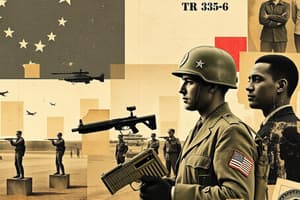Podcast
Questions and Answers
What is the minimum chain size usually used for rescue?
What is the minimum chain size usually used for rescue?
Class A fires involve which of the following materials?
Class A fires involve which of the following materials?
What is the required operating pressure for a high pressure lift bag?
What is the required operating pressure for a high pressure lift bag?
100-147
What is the priority classification for patients whose injuries are serious but not life-threatening?
What is the priority classification for patients whose injuries are serious but not life-threatening?
Signup and view all the answers
Natural gas is heavier than air.
Natural gas is heavier than air.
Signup and view all the answers
What type of fires may require the use of Alcohol Resistant Foam?
What type of fires may require the use of Alcohol Resistant Foam?
Signup and view all the answers
What does HSLA stand for?
What does HSLA stand for?
Signup and view all the answers
Which type of bus does not have a rear exit door?
Which type of bus does not have a rear exit door?
Signup and view all the answers
PPE worn for any rescue activity should comply with __________ Standards for personal safety.
PPE worn for any rescue activity should comply with __________ Standards for personal safety.
Signup and view all the answers
Study Notes
TR VMR Review
- Minimum chain size for rescue operations is 3/8''.
- Class A fires involve ordinary combustibles like wood, cloth, and paper.
- Class B fires concern combustible liquids and gases. Dry Powder is used for Class D fires.
- NFPA 1670 mandates incident commanders assess fire risks at vehicle and machinery incidents.
- Fire personnel should be present with appropriate PPE and a charged hose line at incident scenes for safety.
- Hydraulic cutters can create projectiles when cutting metal; the operating pressure for high-pressure lift bags is 100-147 psi.
- Establish a minimum 25' safe zone when using pneumatic lifting bags, which maintain 100% lifting capacity up to 1-2 inches of inflation.
- Stabilization techniques are similar across passenger vehicles, buses, trucks, and farming machinery.
- Skin contact with LPG or LNG can cause frostbite; precautions are needed during incidents.
- Triage classifications: Yellow (serious but non-life-threatening) and Black (deceased).
- Personal protective equipment (PPE) must comply with NFPA standards, with latex gloves recommended for biological hazards.
- Establish a safety zone as one of the first steps in vehicle extrication.
- The crib box height in vehicle stabilization should not exceed twice the length of the cribbing.
- Seat belts may restrict movement of a displaced roof during extrication operations.
- Side impact airbags provide increased protection in T-bone collisions.
- Approximately 55% of a vehicle's composition is steel, designed for occupant protection in side impact scenarios.
- Smart airbags adjust deployment according to the number of occupied seats in vehicles upon impact.
- Cutting or disconnecting the negative battery cable is the first step in shutting down power in a vehicle.
- Hydraulic tools often struggle with high-strength low alloy (HSLA) materials found in modern vehicles.
- New safety glass technology includes Enhanced Protective Glass (EPG) in vehicles.
- Vehicle impacts create a sequence of events: vehicle impact with an object, occupant impact with the vehicle, and organ impact with body structures.
- Different types of natural gas include LNG and CNG; LPG is heavier than air and can expand significantly when released.
- Popular vehicle designs today involve unibody, space frame, and body over frame technologies.
- Laminated glass is used in windshields for enhanced safety, while tempered glass shatters into small pieces.
- Type A buses are built on cutaway front-section vehicles designed to carry over ten passengers.
- School bus construction includes reinforced sidewalls, vertical load-bearing frame members, and often, heavy-duty vinyl or rubber floors.
- Operating mechanisms for bus doors include pneumatic, hydraulic, and electric systems.
- Tractors generally have high profiles, making them prone to rollovers; equipment like CO2 extinguishers may be needed for emergencies.
- Common stabilization phrase: "Lift a little, crib a little." Cribbing is vital for ensuring safety during vehicle stabilization.
Studying That Suits You
Use AI to generate personalized quizzes and flashcards to suit your learning preferences.
Description
Explore the essentials of TR VMR in this quiz. Focused on fire classes, extinguishing agents, and rescue chain requirements, it aids in mastering critical firefighting concepts. Perfect for incident command training and fire safety knowledge enhancement.




